2021 International Think Tank Forum on Silk Sustainable Development was Successfully Held in Hangzhou

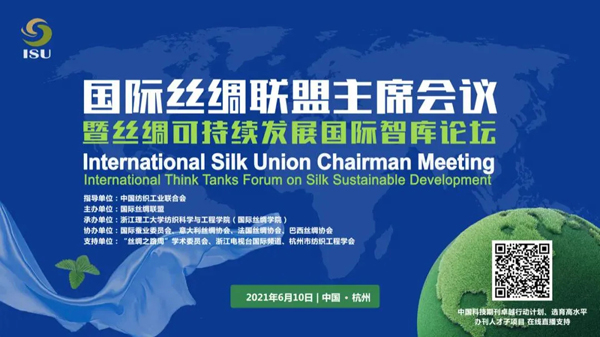
In order to discuss the plans, paths and key technologies for the silk industry to achieve carbon neutrality, promote life cycle assessment research suitable for the entire silk industry chain, maintain the international image of silk and industry interests, and promote the sustainable and green consumption of global silk, On June 10, 2021, International Think Tank Forum on Silk Sustainable Development was successfully held in Hangzhou, China.
Sun Ruizhe, president of China National Textile and Apparel Council, and president of International Textile Manufacturers Federation, gave a video address for the forum. He expressed, global climate change is affecting human society in a speed and a scale we have never seen before. It changes the ecology of industries and the landscape of economy and trade. Sustainability and carbon neutrality have become a general consensus and focus of coopetition of global industries. The main purpose of the Forum is to seek for a scientific solution to achieve carbon neutrality, and an objective methodology to evaluate the life cycle of silk products to protect the image as well as interests of global silk industry. He put forward three suggestions to all the colleagues and friends in the world silk industry: First, we need to set goals by seeking truth from facts. Second, we need to tackle the most pressing issues first to enhance overall capability. Third, we need to work globally to meet challenges.
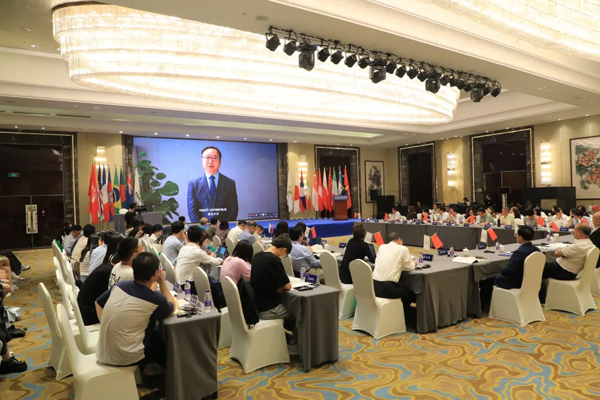
The first half of the forum was presided over by Zhao Feng, vice chairman of ISU, curator of China National Silk Museum, dean of International Institute of Silk of Zhejiang Sci-Tech University; The second half of the forum was presided over by Chen Xiangping, vice chairman of ISU, honorary dean of Sichuan Academy of Silk Science.

Report
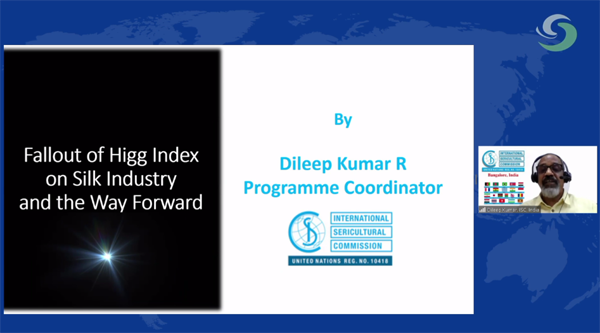
Dileep Kumar R, programme coordinator of International Sericultural Commission, expressed that the higg index portray silk as an unsustainable fibre based on fabricated and unsubstantiated information and data. International Sericultural Commission has embarked into a series of actions intending to withdraw the Higg Index from public space. ISC also would like to collaborate with agencies associated with silk industry to develop global sustainability standards for silk that truly reflect the production process across regions.

Graziano Elegir, head of Innovhub Silk Division, explained the irrationality of the Higg MSI, and introduced that in the last few years, Innovhub, in collaboration with a Swiss University, have conducted a gate-to-gate study for the definition of product category rules aimed at environmental product declaration (EPD). This work could pave the way for future environment labelling and certification of silk products. Next, it will be target a publication in a scientific Journal thus improving visibility of these data.

Ding Xuemei, professor of College of Fashion and Design of Donghua University, introduced the bottlenecks to the calculation and assessment of textile products’ carbon footprint. By deconstructing the relationship and influence factors of energy, material input and output of each unit, the life cycle inventories were decomposed into carbon footprint calculation modules with relative independence and specific functions. The carbon footprint database is established, supporting the carbon emissions reduction of textile industry for the peak carbon emissions.
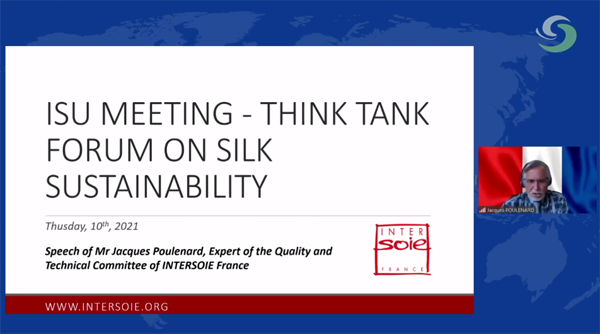
Jacques Poulenard, expert of the Quality and Technical Committee of INTERSOIE France, expressed that Intersoie France gathers all the know-how of the silk chain such as twisters, weavers, dyers, printers and finishers. The manufacturers share inside the Quality and Technical Committee all their Technical, Normative, and Regulatory questions in relation with the markets, their comments and opinions. Some of the main axis of the workshops led by Technical and Quality Committee: a) A new Classification for the raw silk material; b) The Carbon Footprint of the French silk production chain; c) Traceability all along the silk supply chain; d) The promotion of silk fibre, silk products and silk production.

Chen Weiguo, professor of College of Textile Science and Engineering (International Institute of Silk) of Zhejiang Sci-Tech University, expressed that the modernization of silk industries has brought some environmental problems. In the last two decades, the team have been working in many research areas relating to the sustainable issue of silk. There are some examples listed as following: selection and extraction of natural dyes from plants and traditional Chinese medicine with non-toxicity and easy degradation, synthesis of dyes with non-toxicity, easy degradation and the dyeing without salts, cold-pad and storage dyeing with low energy consumption, supercitical CO2 dyeing, etc.
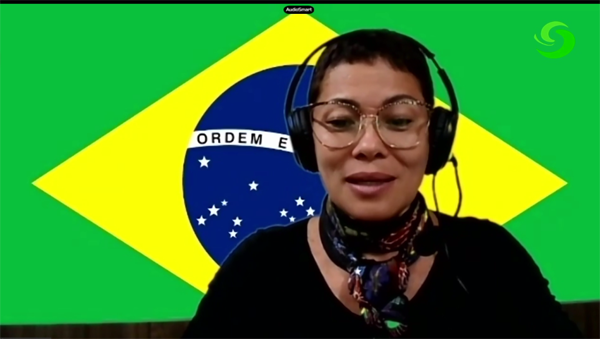
Renata Amano, president of Brazilian Silk Association, introduced the sustainability of silk and the sustainable development target of Brazilian silk, and expressed that strategies must be designed to overcome technical, social and economic barriers. Finally, she introduced the two Brazilian experts who published the theme report next.

Joao Berdu, project manager of Vale da Seda, expressed that in the past, people usually compared the weight and shining of silk with other fabrics, but now they are more inclined to compare sustainability and environmental impact. For sure it is in the interest of silk industry to promote independent life cycle assessment study on silk by joined efforts between International Sericultural Commission and International Silk Union. It is highly positive to have a study group to promote the production of more representative technical material to promote independent life cycle assessment of silk.

Silvia Barcelos, professor of State University of Maringa, used the ISOs 14040 and 14044, and cradle-to-gate (C2G) approach, analyzed the life cycle assessment of silk cocoon production in Brazil, which comprised the stages from the cultivation of mulberry trees up to stage when the fresh cocoons are delivered to the rearing industry. It was possible to identify that the impacts of the production of mulberry trees stood out in comparison with those of the production of the silk cocoons. Based on the impacts identified, several opportunities can be put forward to improve the environmental profile of production of silk cocoons.
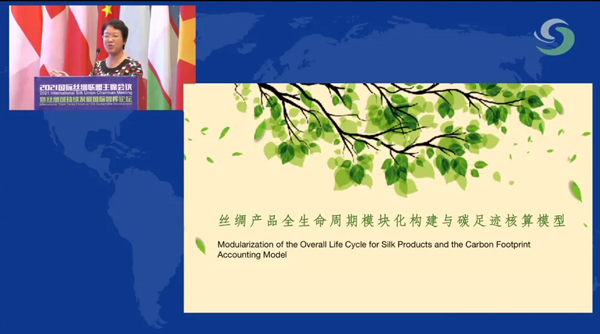
Xu Jianmei, associate professor of School of Textile and Clothing Engineering of Soochow University, established an uniform and universal method in life cycle assessment for silk products, constructed a modularization method in determining SB of the silk products, analyzed the life cycle assessment framework of each module, the CFP conversion factors of energy sources and materials involved in the whole life cycle. Thus by combination of different modules, the CFP can be calculated on a standardized method.

Chen Yican, general manager of Indidye Natural Color Co., Ltd., introduced the sustainability of plant dyes, plant dyes standard and PDS manufacturers Union, plant dyeing industry and carbon neutralization / carbon peak. The application of plant dyes in silk fabric printing and dyeing including silk fabric dyeing and printing, silk fiber dyeing, silk garment dyeing, etc.
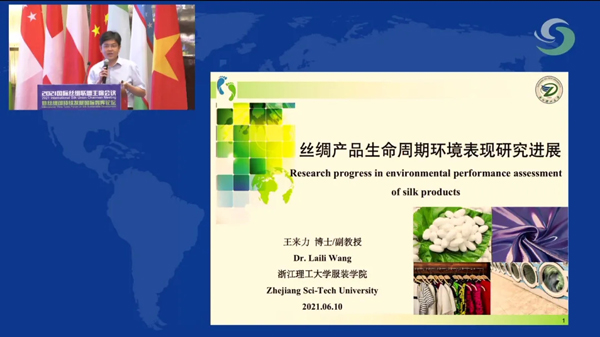
Wang Laili, associate professor of School of Fashion Design & Engineering of Zhejiang Sci-Tech University, expressed that in the research process of environmental performance in the life cycle of silk products, the positive performances during the life cycle of silk products should be considered, and constructed the using and washing models, recycling and reusing models, built input & output inventory database that comprehensively considers national, regional, technical level and other factors, choosing an appropriate normalization method for result reporting to achieve the comparability of environmental performances of different silk products is also very important.
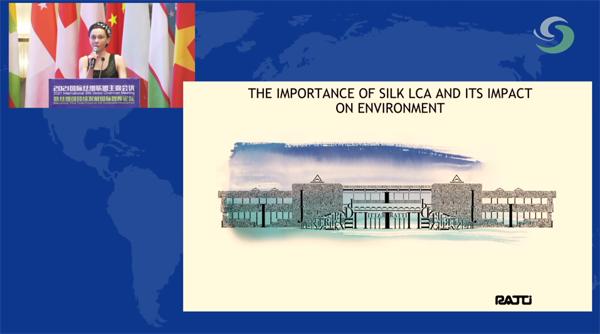
Emilia Simoncini, representative of Ratti SpA, explained the impact of the natural environment on humans through a set of photos and data, and introduced the life cycle assessment of the main silk production chain. It is hoped that the industry will work together to promote an objective and comprehensive silk life cycle assessment.

Song Bo, deputy secretary-general of the Life Cycle Assessment & Management, introduced the team’s national survey on the status quo of the silk industry, collected LCA data on silk products of different processes, conducted silk scarf carbon footprint analysis, etc., and shared with the guests the carbon footprint accounting and management for support carbon emission reduction in the silk product supply chain.

Francesco Ongetta, purchasing manager of Ongetta srl, expressed that 2020 has been an extremely difficult one for all of us operating in the textile field. In Italy, us as Ongetta srl and the Italian Silk Office resume production as much as possible to increase the proportion of silk in the textile industry. Silk has peculiar features in sustainability, mechanic and physics, and it is necessary to jointly maintain the image of silk.
During the forum, International Silk Union (ISU) joined hands with International Sericultural Commission (ISC), Ufficio Italiano Seta (UIS), INTERSOIE France and Brazilian Silk Association (ABRASEDA), released the Proposal for the Comprehensive and Objective Assessment of Life Cycle of Silk Products.
Guider: China National Textile and Apparel Council
Organizer: International Silk Union
Sponsor: College of Textile Science and Engineering(International Institute of Silk ), Zhejiang Sci-Tech University
Co-organizers: International Sericultural Commission, Ufficio Italiano Seta, Intersoie France, Brazilian Silk Association
Supporter: Academic Committee of “Silk Road Week”, Zhejiang TV International Channel, Hangzhou Textile Engineering Society

